This is an incomplete list of Martian meteorites i.e. meteorites that have been identified as having originated from Mars.
As of September 2020 [update] , 277 meteorites had been classified as Martian, less than half a percent of the 72,000 meteorites that have been classified. [1] On 17 October 2013, NASA reported, based on analysis of argon in the Martian atmosphere by the Mars Curiosity rover, that certain meteorites found on Earth previously only thought to be from Mars, could now be confirmed as from Mars. [2] The list does not include meteorites found on Mars by the various rovers.
Where multiple meteorites are listed, they are believed to be pieces of the same original body. The mass shown is the total recovered.
Abbreviations:

A Martian meteorite is a rock that formed on Mars, was ejected from the planet by an impact event, and traversed interplanetary space before landing on Earth as a meteorite. As of September 2020, 277 meteorites had been classified as Martian, less than half a percent of the 72,000 meteorites that have been classified. The largest complete, uncut Martian meteorite, Taoudenni 002, was recovered in Mali in early 2021. It weighs 14.5 kilograms and is on display at the Maine Mineral and Gem Museum.
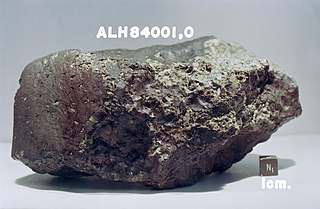
Allan Hills 84001 (ALH84001) is a fragment of a Martian meteorite that was found in the Allan Hills in Antarctica on December 27, 1984, by a team of American meteorite hunters from the ANSMET project. Like other members of the shergottite–nakhlite–chassignite (SNC) group of meteorites, ALH84001 is thought to have originated on Mars. However, it does not fit into any of the previously discovered SNC groups. Its mass upon discovery was 1.93 kilograms (4.3 lb).
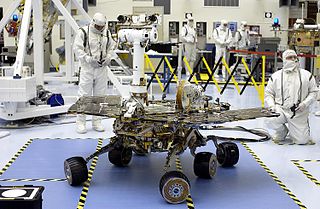
Spirit, also known as MER-A or MER-2, is a Mars robotic rover, active from 2004 to 2010. Spirit was operational on Mars for 2208 sols or 3.3 Martian years. It was one of two rovers of NASA's Mars Exploration Rover Mission managed by the Jet Propulsion Laboratory (JPL). Spirit landed successfully within the impact crater Gusev on Mars at 04:35 Ground UTC on January 4, 2004, three weeks before its twin, Opportunity (MER-B), which landed on the other side of the planet. Its name was chosen through a NASA-sponsored student essay competition. The rover got stuck in a "sand trap" in late 2009 at an angle that hampered recharging of its batteries; its last communication with Earth was on March 22, 2010.

Heat Shield Rock is a basketball-sized iron-nickel meteorite found on the Meridiani Planum plain of Mars by the Mars rover Opportunity in January 2005.
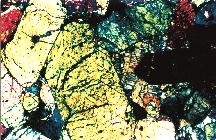
Chassigny is a Martian meteorite which fell on October 3, 1815, at approximately 8:00 am, in Chassigny, north-eastern France. Chassigny is the meteorite for which the chassignites are named and gives rise to the "C" in the name of the SNC group of meteorites. Chassigny is an olivine cumulate rock (dunite). It consists almost entirely of olivine with intercumulus pyroxene, feldspar, and oxides. It was the only known chassignite until NWA2737 was found in the Moroccan Sahara in northwest Africa.

Nakhla is a Martian meteorite which fell in Egypt in 1911. It was the first meteorite reported from Egypt, the first one to suggest signs of aqueous processes on Mars, and the prototype for Nakhlite type of meteorites.

The Shergotty meteorite is the first example of the shergottite Martian meteorite family. It was a 5-kilogram (11 lb) meteorite which fell to Earth at Sherghati, in the Gaya district, Bihar, India on 25 August 1865, and was retrieved by witnesses almost immediately. Radiometric dating indicates that it solidified from a volcanic magma about 4.1 billion years ago. It is composed mostly of pyroxene and is thought to have undergone preterrestrial aqueous alteration for several centuries. Certain features within its interior are suggestive of being remnants of biofilm and their associated microbial communities.

Nakhlites are a group of Martian meteorites, named after the first one, Nakhla meteorite.

The composition of Mars covers the branch of the geology of Mars that describes the make-up of the planet Mars.

The Tissint meteorite is a Martian meteorite that fell in Tata Province in the Guelmim-Es Semara region of Morocco on July 18, 2011. Tissint is the fifth Martian meteorite that people have witnessed falling to Earth, and the first since 1962. Pieces of the meteorite are on display at several museums, including the Museum of Natural History of Vienna and the Natural History Museum in London.
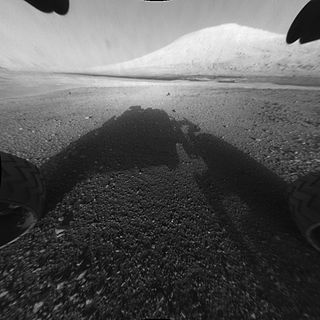
Mount Sharp, officially Aeolis Mons, is a mountain on Mars. It forms the central peak within Gale crater and is located around 5.08°S 137.85°E, rising 5.5 km (18,000 ft) high from the valley floor. Its ID in the United States Geological Survey's Gazetteer of Planetary Nomenclature is 15000.
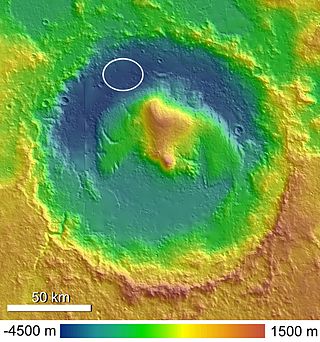
Aeolis Palus is a plain between the northern wall of Gale crater and the northern foothills of Aeolis Mons on Mars. It is located at 4.47°S 137.42°E.

Sample Analysis at Mars (SAM) is a suite of instruments on the Mars Science Laboratory Curiosity rover. The SAM instrument suite will analyze organics and gases from both atmospheric and solid samples. It was developed by the NASA Goddard Space Flight Center, the Laboratoire des Atmosphères Milieux Observations Spatiales (LATMOS) associated to the Laboratoire Inter-Universitaire des Systèmes Atmosphériques (LISA), and Honeybee Robotics, along with many additional external partners.

Curiosity is a car-sized Mars rover exploring Gale crater and Mount Sharp on Mars as part of NASA's Mars Science Laboratory (MSL) mission. Curiosity was launched from Cape Canaveral (CCAFS) on November 26, 2011, at 15:02:00 UTC and landed on Aeolis Palus inside Gale crater on Mars on August 6, 2012, 05:17:57 UTC. The Bradbury Landing site was less than 2.4 km (1.5 mi) from the center of the rover's touchdown target after a 560 million km (350 million mi) journey.
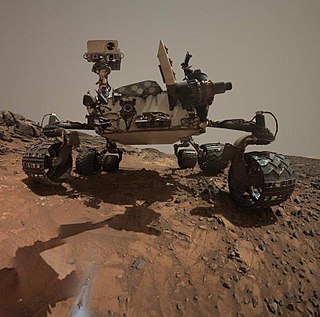
The Mars Science Laboratory and its rover, Curiosity, were launched from Earth on 26 November 2011. As of October 15, 2024, Curiosity has been on the planet Mars for 4335 sols since landing on 6 August 2012. (See Current status.)

Northwest Africa 7034 is a Martian meteorite believed to be the second oldest yet discovered. It is estimated to be 4.43 billion years old and contains the most water of any Martian meteorite found on Earth. Although it is from Mars it does not fit into any of the three SNC meteorite categories, and forms a new Martian meteorite group named "Martian ". Nicknamed "Black Beauty", it was purchased in Morocco and a slice of it was donated to the University of New Mexico by its American owner. The image of the original NWA 7034 was photographed in 2012 by Carl Agee, University of New Mexico.

Yamato 000593 is the second largest meteorite from Mars found on Earth. Studies suggest the Martian meteorite was formed about 1.3 billion years ago from a lava flow on Mars. An impact occurred on Mars about 11 million years ago and ejected the meteorite from the Martian surface into space. The meteorite landed on Earth in Antarctica about 50,000 years ago. The mass of the meteorite is 13.7 kg (30 lb) and has been found to contain evidence of past water alteration.

Opportunity is a robotic rover that was active on the planet Mars from 2004 to 2018. Launched on July 7, 2003, Opportunity landed on Mars' Meridiani Planum on January 25, 2004, at 05:05 Ground UTC, three weeks after its twin Spirit (MER-A), also part of NASA's Mars Exploration Rover Mission, touched down on the other side of the planet. While Spirit became immobile in 2009, and ceased communications in 2010, Opportunity exceeded its planned 90 sol duration of activity by 14 years 46 days. Opportunity continued to move, gather scientific observations, and report back to Earth until 2018. What follows is a summary of events during its continuing mission.
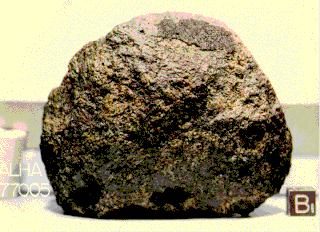
Allan Hills 77005 is a Martian meteorite that was found in the Allan Hills of Antarctica in 1977 by a Japanese National Institute of Polar Research mission team and ANSMET. Like other members of the group of SNCs, ALH-77005 is thought to be from Mars.
Breccia, probably paired with NWA 7034